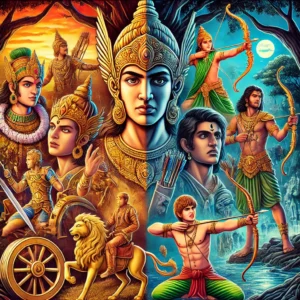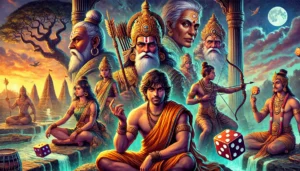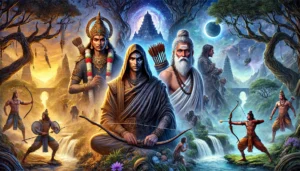
Unsung heroes in Indian mythology stories
Unsung Heroes and Anti-Heroes in Indian Mythology: Tales of Complexity and Humanity
Indian mythology is a vast ocean of narratives where gods, demons, and humans come together to weave intricate tales of morality, valor, and destiny. While the spotlight often shines on heroic figures like Rama, Krishna, and Arjuna, the stories of unsung heroes and anti-heroes are equally compelling. These characters, often relegated to the shadows, embody the complexities of human nature, showcasing virtues, flaws, and dilemmas that resonate with the struggles of everyday life.
In these lesser-explored tales lie lessons of resilience, sacrifice, and moral ambiguity, offering a deeper understanding of the human condition. Let us delve into the lives of these fascinating characters.
Table of Contents

Unsung heroes in Indian mythology stories
Unsung Heroes: Silent Beacons of Virtue
- Eklavya: The Sacrificial Devotee
Eklavya’s story from the Mahabharata is one of relentless dedication and the tragic price of societal discrimination. Born into a Nishada (tribal) family, Eklavya’s determination to become a master archer led him to self-train under the symbolic guidance of Guru Dronacharya. When his unparalleled skill threatened to outshine Arjuna, Dronacharya demanded Eklavya’s thumb as a token of loyalty. Despite the grave injustice, Eklavya complied without protest, embodying humility and devotion.
Eklavya’s tale is a stark commentary on the caste-based inequalities that existed in ancient times, highlighting how talent and dedication are often overlooked due to systemic prejudice. His sacrifice stands as a powerful example of unacknowledged greatness.
- Karna: The Tragic Hero
Karna, born to Kunti and the Sun God, was abandoned as an infant and raised by a charioteer. Despite his royal lineage, Karna faced lifelong humiliation due to his perceived low birth. His brilliance as a warrior, his unwavering loyalty to Duryodhana, and his generosity earned him respect, but his tragic life was marked by moral dilemmas and unfulfilled potential.
Karna’s adherence to his promises, even at the cost of his own life, and his inner conflict between loyalty and righteousness, make him one of the most layered characters in Indian mythology. His story serves as a reminder of the struggles faced by those marginalized by society, even when they possess extraordinary abilities.
- Mandodari: The Silent Voice of Reason
Mandodari, Ravana’s wife in the Ramayana, is an epitome of wisdom and morality. Despite being the queen of Lanka, Mandodari is often overshadowed by the larger-than-life personas of Ravana and Sita. However, her character is one of profound strength and integrity.
Mandodari repeatedly advised Ravana to abandon his obsession with Sita and choose the path of righteousness, demonstrating her courage to stand against her husband’s destructive ambitions. Her story is a subtle yet powerful depiction of how women in mythology often play the role of moral anchors, even when their voices go unheard.
- Shabari: The Devoted Ascetic
Shabari, a tribal woman and devotee of Lord Rama, is a figure of unparalleled devotion in the Ramayana. Living a life of simplicity and penance, she awaited Rama’s arrival for years. When he finally came, she offered him berries, tasting each one to ensure they were sweet—a gesture that symbolizes selfless love and devotion.
Her story, though brief, is profound. Shabari’s devotion transcends societal barriers, emphasizing that spirituality and faith are not bound by caste or class. She stands as a beacon of inclusivity and pure devotion.

Unsung heroes in Indian mythology stories
Anti-Heroes: Shadows of Complexity
- Ravana: The Flawed Genius
Ravana, the primary antagonist of the Ramayana, is a character of great complexity. While remembered as the demon king who abducted Sita, Ravana was also a brilliant scholar, a devout Shiva bhakta, and an exceptional ruler. His downfall was his hubris and his inability to control his desires, particularly his obsession with Sita.
Ravana’s character highlights the duality of human nature. Despite his virtues, his arrogance led to his downfall, making him a cautionary figure who reminds us of the perils of unchecked ambition and pride.
- Duryodhana: The Misguided Prince
Duryodhana, the eldest Kaurava in the Mahabharata, is often vilified for his envy and greed. However, his character also has admirable traits, such as his unwavering loyalty to Karna and his determination to challenge the norms that excluded him.
Duryodhana’s actions, driven by his sense of entitlement and resentment towards the Pandavas, culminated in the Kurukshetra war. Yet, his complexities make him a relatable figure—a man consumed by his insecurities but not devoid of nobility.
- Mahishasura: The Demon with a Cause
Mahishasura, the demon defeated by Goddess Durga, is traditionally depicted as a symbol of evil. However, his backstory adds layers to his character. A devout worshipper of Brahma, Mahishasura sought power to protect his people, the asuras, who were often oppressed by the devas.
His eventual descent into tyranny reflects how power can corrupt even the most righteous intentions. Mahishasura’s tale is a nuanced exploration of how circumstances can transform a hero into a villain.
- Ashwatthama: The Cursed Warrior
Ashwatthama, the son of Dronacharya, is one of the most tragic anti-heroes in the Mahabharata. A brilliant warrior, Ashwatthama’s rage and grief after his father’s death led him to commit heinous acts, including the massacre of the Pandavas’ children.
Cursed with immortality, Ashwatthama roams the earth as a symbol of eternal suffering. His story serves as a grim reminder of the destructive power of unchecked emotions and the consequences of morally questionable actions.
Why Their Stories Matter
The tales of these unsung heroes and anti-heroes challenge the simplistic notions of good versus evil. They explore the gray areas of morality, where intentions and actions are often in conflict. These characters teach us:
Empathy for Flawed Beings: Heroes are not always perfect, and villains are not entirely evil.
The Cost of Choices: Every decision, whether noble or selfish, comes with consequences.
Unrecognized Contributions: Many individuals’ sacrifices go unnoticed, yet they shape the world around them.
Conclusion
Indian mythology’s unsung heroes and anti-heroes are mirrors of human existence, reflecting the struggles, aspirations, and flaws inherent in us all. Their stories, though often overlooked, offer profound insights into the nature of duty, loyalty, ambition, and morality. By revisiting these narratives, we honor the complexity of their characters and the timeless lessons they impart. These tales remind us that greatness lies not only in celebrated victories but also in quiet sacrifices and the courage to confront one’s inner demons.

Unsung heroes in Indian mythology stories
FAQs for “Beyond Good and Evil: Unsung Heroes and Anti-Heroes in Indian Mythology”:
- What is the article about?
The article delves into the fascinating world of Indian mythology, focusing on characters who defy traditional labels of good and evil. It highlights the stories of unsung heroes and anti-heroes—figures often overlooked or misunderstood—exploring their complexities, motivations, and humanity. These characters add depth to mythological narratives by representing the moral ambiguity inherent in life.
- Why are unsung heroes and anti-heroes important in Indian mythology?
Unsung heroes and anti-heroes reflect the complexities of human nature. They provide insight into moral dilemmas, show the impact of personal choices, and embody traits like resilience, intelligence, or loyalty. Their stories emphasize that greatness is not always synonymous with moral perfection and that flaws and virtues coexist in all individuals. These figures also illustrate how mythology is not just about idealized heroes but about exploring human challenges and contradictions.
- Who are some of the key characters discussed in the article?
The article explores characters like:
Karna: A tragic hero from the Mahabharata who is both noble and flawed.
Ashwatthama: A warrior torn between loyalty and revenge.
Shakuni: A cunning strategist driven by a personal vendetta.
Ravana: A scholar-king with great devotion and wisdom, yet consumed by pride.
Ekalavya: A symbol of dedication and sacrifice, sidelined by societal norms.
These characters challenge traditional hero-villain archetypes and highlight the shades of morality present in mythological narratives.
- What lessons can we learn from these characters?
These figures teach us about:
Resilience: Overcoming adversity and staying true to one’s goals (e.g., Ekalavya).
Consequences of Choices: How actions, even noble ones, can lead to tragic outcomes (e.g., Karna).
The Cost of Ambition: The dangers of unbridled ambition and unchecked desires (e.g., Ravana).
Empathy: Understanding diverse perspectives, even those of perceived villains.
These lessons are timeless and encourage self-reflection in our personal and professional lives.
- How do Indian myths handle the concept of morality?
Unlike many traditions that emphasize clear distinctions between good and evil, Indian mythology adopts a more nuanced approach. It portrays characters as multi-dimensional, with motivations shaped by their circumstances, duties (dharma), and personal struggles. This perspective encourages readers to evaluate morality contextually rather than absolutistically.
- How does dharma influence the actions of these characters?
Dharma, or the concept of righteous duty, is a recurring theme in Indian mythology. Many unsung heroes and anti-heroes operate based on their understanding of dharma, which can conflict with societal norms or the expectations of others. For example:
Karna struggles to balance his loyalty to Duryodhana with his knowledge of right and wrong.
Ashwatthama justifies his revenge as an act of dharma for his father’s death.
These conflicts highlight the complexity of dharma and its role in guiding human behavior.
- Are there parallels between mythological anti-heroes and modern figures?
Yes, many anti-heroes from mythology resonate with contemporary fictional characters like anti-heroes in books, movies, and TV shows. Characters like Karna or Ravana are similar to modern anti-heroes who are driven by personal struggles, moral conflicts, or societal rejection. Their narratives appeal to modern audiences because they embody the human condition in its entirety—strengths, weaknesses, and contradictions.
- Why are some characters considered unsung?
Many characters, such as Mandodari (Ravana’s wife) or Ekalavya, play crucial roles in mythology but are overshadowed by more prominent figures like Arjuna or Sita. These unsung heroes often make sacrifices or display immense wisdom, loyalty, or bravery, but their contributions are not as widely celebrated. The article seeks to spotlight their importance and ensure their stories are given due recognition.
- What role does empathy play in understanding these characters?
Empathy is key to appreciating the complexities of anti-heroes and unsung heroes. By understanding their motives and challenges, we can see beyond their actions to the human emotions driving them. For instance, Ravana’s arrogance stemmed from his immense knowledge and power, while Karna’s choices were influenced by his lifelong struggle for acceptance.
- How do these stories remain relevant in today’s world?
The stories of these characters reflect timeless human struggles—identity, loyalty, ambition, and the search for meaning. In today’s fast-paced, morally ambiguous world, their tales remind us that:
Every individual has their own battles and perspectives.
The consequences of actions, whether good or bad, can ripple through society.
Redemption and resilience are always possible, even for the most flawed individuals.
These narratives encourage introspection and a deeper understanding of ourselves and others.
- Why does Indian mythology avoid rigid moral binaries?
Indian mythology emphasizes the cyclical nature of life and the interconnectedness of actions. Instead of categorizing individuals as purely good or evil, it highlights the interplay of circumstances, choices, and consequences. This approach aligns with the philosophy of karma and dharma, which focus on personal growth and learning from life’s complexities.
- How do these characters inspire modern storytelling?
Many themes and archetypes from Indian mythology, including the morally complex anti-hero, have inspired modern literature, cinema, and television. For instance, the struggles of Karna have parallels in underdog stories, while Ravana’s tragic flaws resemble those of Shakespearean characters like Macbeth. These figures continue to inspire narratives that explore human emotions, dilemmas, and growth.
- What unique perspective does this article bring?
The article brings a fresh lens to Indian mythology by spotlighting characters who defy traditional stereotypes. It encourages readers to appreciate the moral, emotional, and psychological depths of these figures and how their stories hold lessons for modern life.
- How does this article connect mythology with real life?
By examining the complexities of these characters, the article draws parallels between mythological stories and real-world issues like ambition, loyalty, societal rejection, and personal identity. It encourages readers to reflect on their own lives and challenges through the lens of ancient wisdom.
- Who is this article for?
This article is for anyone interested in Indian mythology, philosophy, or literature, as well as those seeking insights into human nature and moral complexity. It’s especially valuable for readers looking to explore mythological stories beyond the conventional hero-villain dichotomy.
Summary
“Beyond Good and Evil: Unsung Heroes and Anti-Heroes in Indian Mythology” explores the nuanced characters in Indian mythology who defy traditional notions of morality. Unlike clear-cut heroes or villains, these figures embody complex traits, reflecting both virtues and flaws. The article delves into the stories of individuals like Karna, Ravana, and Ashwatthama, who challenge black-and-white definitions of good and evil. It highlights how their motivations, struggles, and actions reveal deeper truths about human nature, dharma, and ethical dilemmas. By analyzing these characters, the piece sheds light on the rich tapestry of Indian mythology, offering timeless lessons on empathy, choices, and the gray areas of morality.
Related Articles
- The Tridevi: Lakshmi, Saraswati, and Parvati – Their Roles and Powers
- “Divine Creatures of Ancient Indian Scriptures: Exploring the Role of Animals in the Vedas, Puranas, and Mahabharata”
- Nature and Spirituality: Exploring the Sacred Essence of the Himalayas, Ganga, and Other Natural Wonders”
- “Reviving the Gurukul System: Relevance and Lessons for Modern Education”
- “Exploring Greek and Indian Mythology: Similarities Between Greek and Indian Mythology “
- “Embracing Sattvic Living: Harmonizing Mind, Body, and Soul Through Food and Lifestyle”
- “Charity and Prosperity: Exploring the Concept of Daan and Its Financial Relevance in Modern Life”
- How to Build an Eco-Friendly Home Inspired by Vastu Shastra
- Comparison of Ancient and Modern Sports: How Traditional Sports Have Influenced Contemporary Games
- “Timeless Lessons from Ancient Tales: Linking Samudra Manthan and Ganga’s Descent to Modern Ecological Challenges”
- “Reviving Sanskrit: How AI is Preserving Ancient Languages for the Future”
- “Mathura: The Sacred Land of Lord Krishna’s Divine Leelas”
- Investing for Future Generations: Lessons from Indian Traditions on Legacy Building and Wealth Preservation
- “Ancient Indian Wisdom: Timeless Lessons for Tackling Today’s Climate Crisis”
- “Artificial Intelligence and Spirituality: Transforming Ancient Practices for the Modern World”
- “Gold and Real Estate in India: Timeless Assets Shaping Financial Strategies”
- “Divine Feminine Power in Hindu Mythology: The Legends of Durga, Saraswati, and Lakshmi”
- “Divine Beings of Sanatan Dharma: The Spiritual Significance of Sacred Animals in Hinduism”
- “Symbolism in Mythological Art: Unlocking Hidden Meanings in Ancient Temple Carvings”
- “Exploring Technological Advancements in Ancient India and Civilizations: Vimana, Metallurgy, & Water Management systems”
- Unveiling the Mysteries: Ancient Temples of Sanatan Dharma , Mysterious Temples of India
- “The Scientific Knowledge of Sanatan Dharma: Ancient Wisdom Meets Modern Science”
- Ancient Indian Sports and Games: Celebrating a Legacy of Skill, Strength & Strategy”
- “Exploring the Cosmic Link: The Connection Between Astronomy and Vedic Astrology”
- The Power of Sanskrit: Unlocking the Divine Language of the Gods
- “The End of Kaliyuga: A Sanatan Insight into the World’s Final Chapter”
- Explore more articles on Prachin Sanatan Yuga.
